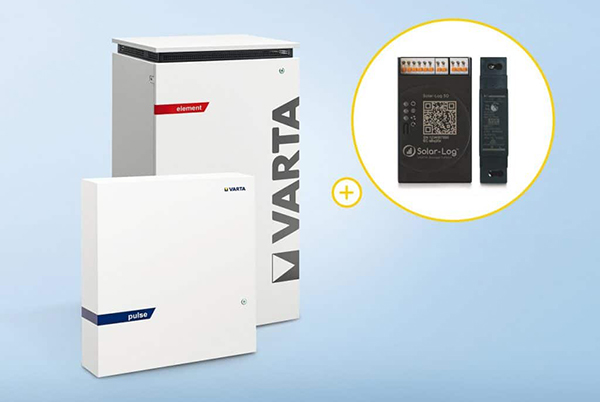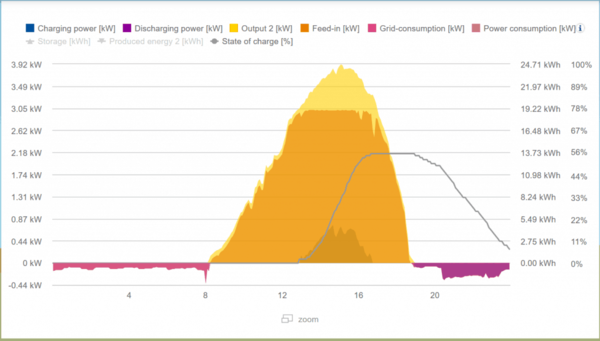Store PV Energy and Increase PV Yields
by Maria Beck, Varta Storage GmbH | 08/26/2019

[Guest article] Those who purchase a PV system often do so not only for the sake of the environment. Many system owners also want to make themselves independent of large electricity providers and thus of rising electricity prices. In order to make the purchase of the PV system economically worthwhile despite falling feed-in tariffs, it should run as efficiently as possible. This is achieved with increased energy savings and an increase in PV yields. With an energy storage system, the first step in the right direction has already been taken. The self-consumption of the PV energy can be increased to up to 80% with this and thus the energy savings can be significantly increased. PV yields are also optimized even further with the help of an energy storage system. We describe below how this optimization is achieved.
Optimizing PV Yields through Energy Storage
All VARTA energy storage systems are equipped with an intelligent Energy management system system that distributes the self-produced energy as efficiently as possible. In addition, settings can also be made that optimize PV yields. This is because, especially with subsidy programs, the proportion of energy that may be fed into the grid is capped. If this limit is threatened to be exceeded, the PV inverter is throttled so that the PV yield is lower than would be possible. In order to avoid the throttling, the surplus that would lead to the limit being exceeded can be stored with a VARTA energy storage device.
Which strategy achieves improved charging?
However, especially on sunny days, reaching this limit is imminent at a relatively early stage. The energy storage would already be fully charged before or during the midday peak and the inverter would have to be throttled. To prevent the energy storage from being fully charged too early, a charging strategy can be determined in the settings in the web portal. Threshold values for three phases during the day are set for a sensible strategy. The goal is to have enough capacity ready for the peak of production and at the same time store enough energy for evening and nighttime consumption. This function is available on the VARTA element from version S3 and on the VARTA pulse. More information about these settings can be found here.

The graphic shows an example of the production and consumption curve with PV yield optimization. The production surplus (shown in yellow), which would be lost without a charging strategy, can be stored thanks to the available capacity.
Integrate Weather Forecast and Load Forecast Correctly
With a weather and load forecast based charging strategy, yield optimization is even more efficient. When charging the energy storage unit, additional consideration is given to how the weather will be and which consumers are expected to be running. This function is already integrated in the VARTA element S4 and the VARTA pulse neo. For all other VARTA energy storage systems, the Solar-Log™ (i.e. Solar-Log™ 50 in the VARTA Storage Edition) can be used for this purpose. In addition to PV yield optimization, the Solar-Log™ also takes over the throttling of the inverter for these models.
Which factors are important for intelligent battery charging?
The Solar-Log™ Energy Manager calculates a daily individual charging period for the energy storage based on weather forecast data, consumption analyses, the size of the photovoltaic system, and the capacity of the battery system. In this way, as little PV energy as possible should be lost, but at the same time the energy storage system should be sufficiently charged to be able to supply the consumers in the evening and night hours. In addition to the charging strategy, the energy manager also enables dynamic active power limitation, visualization of consumption and production data, and monitoring of the systems.
From Theory to Practice: Charging Energy Storage Systems while Taking the Relevant Factors into Account
"It's a Tuesday, for example. Based on the learned consumption curves, it can be seen that there is usually a high demand for energy at lunchtime. In addition, the weather forecast for this Tuesday predicts moderate temperatures and high solar radiation. Consequently, a maximum PV yield can be expected. The 10 kWp high-power PV system is limited by EEG requirements to 60% of the installed module power, which means that the feed-in power must be limited on this day. So that the energy generated above this is not lost unused, it must be consumed itself.
The Solar-Log™ shifts the charging of the battery to the period of the production peaks, so these do not have to be regulated. Since a high self-consumption is calculated from midday, the Solar-Log™ extends the charging period of the battery. The goal is to achieve a 100% charge of the battery."
For more information, also contact the VARTA Storage Ltd. service team at info(at)varta-storage.com or +49 9081 240 86 60 is at your disposal.
Back to the overview


